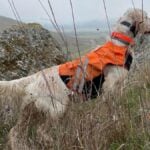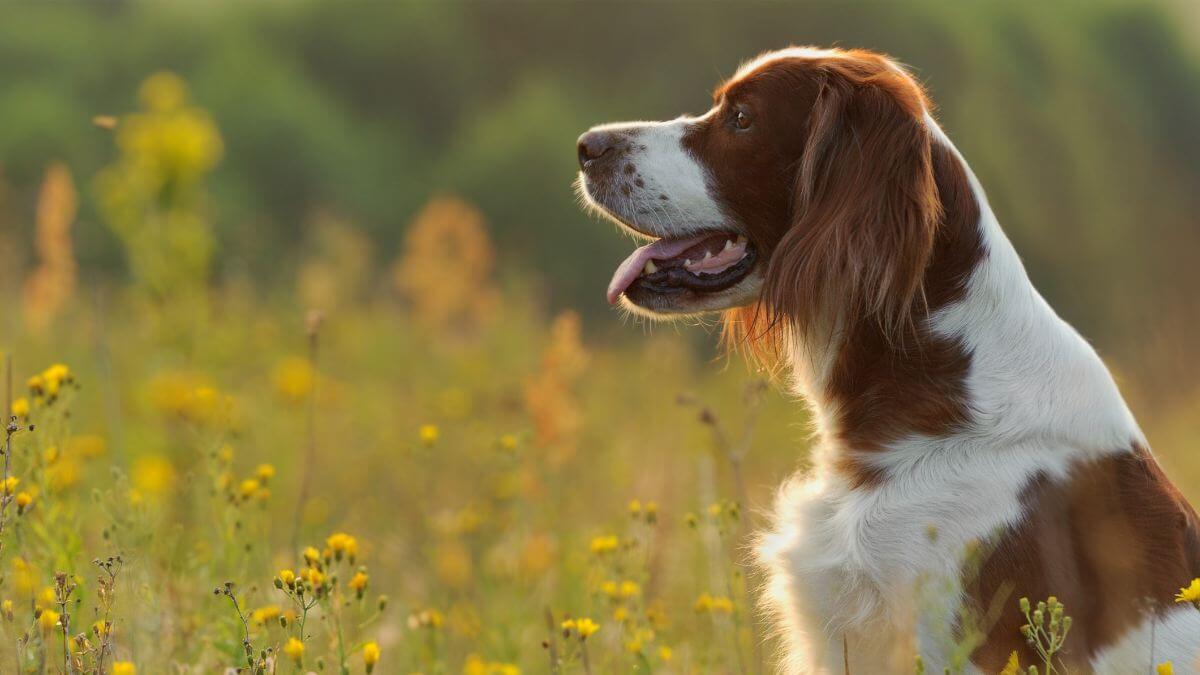
Home » The Irish Red and White Setter

This article was originally published in Showsight Magazine, July 2011 issue.
The absolute history of the Setter from Ireland is questionable due to the lack of records from ancient times. What has survived the distortions of time and oral history are several paintings and a few written descriptions from the 17th and 18th centuries that attest to the presence of the white “setting dogges” with red markings.
The earliest references to any kind of setter are from the 16th century with depictions of a hunter with a net and a supine dog pointing toward a doomed grouse or quail. The “setting spaniel” is one of the earliest references to the setters we know today. Hunting with a net requires the dog to find the bird, freeze the bird in place, and not be so close to the bird that the hunter nets the bird and the dog at the same time. Only a superior dog could manage all of these tasks.
Legend and paintings from the 17th century reflect dogs very similar to the documented pedigrees of the 18th century. Despite the fact that we can actually see 200-year-old paintings of dogs similar to today’s dogs, we should keep in mind that before the middle of the 19th century, dogs were bred to work, and the notion of breeders being concerned about any particular conformation has never been demonstrated.
By the end of the 18th century, the white and red breed was well established, and several kennels were known for supplying purebred dogs. During the 19th century, the red dogs became established in ever greater numbers, eventually becoming the predominant variety.
World War I brought great hardship to the people of Ireland and their dogs. The number of white and red setters declined to nearly zero. Anna Redlich credits Rev. Noble Huston of Ballynahinch, County Down, with saving the line and gradually building up the numbers. With the aid of his cousin, Dr. Elliott, he was able to slowly bring back the breed.
Dr. Elliott lived in a house named Eldron, and that prefix is in the names of dogs bred in the 1920s and 1930s. The Rev. Huston did not keep official pedigrees but recorded his litters in the parish register. Although most of the dogs were kept in Ireland, a single dog was sent to the United States, two to Spain, and several to England.
The next important players in this story are Mr. and Mrs. Will Cuddy. In 1940, Mrs. Maureen Cuddy (nee Clarke) was given a sickly puppy bitch. She nursed the puppy to health and called her puppy Judith Cunningham of Knockalla. It is highly probable that every recorded Irish Red and White Setter today is descended from this bitch. The Cuddys were instrumental in forming an Irish Red and White Setter group in Ireland and gaining recognition of the breed.
Mrs. Cuddy carried on a lengthy correspondence with the aging Rev. Huston and is responsible for researching and preserving much of the early 20th-century history of the breed. In 1944, the Irish Red and White Setter Society formed in Ireland.
Between the end of WWII and the early 1980s, the Irish slowly built up the numbers of what became officially known as Irish Red and White Setters. The breed spread to England. Both the Irish Kennel Club and the Kennel Club (UK) came to recognize the IR&WS as a breed separate from the Irish Setter. The IR&WS again came to the United States in the 1960s with the import of a few dogs by a couple of individuals. In the 1980s, breeding pairs were imported and the gradual increase in the IR&WS population began. Since that time, several other imports arrived, and a slow breeding program has continued.
Beginning in 1996, AKC started recording the Irish Red and White Setter in the Foundation Stock Service. The breed became eligible to compete in Pointing Breed Hunting Tests, Obedience, Agility, and Rally as of April 1, 2004, and in the Miscellaneous Class at shows on June 27, 2007. On January 1, 2009, the Irish Red and White Setter was assigned to the Sporting Group and became AKC’s 159th breed.
Known as a “Gentleman’s Bird Dog,” the Irish Red and White Setter is a very versatile upland gun dog that can find game in the heaviest cover.
Training an IRWS should always be done with positive reinforcement. They tend to be on the soft side and respond best to gentle persuasion. They are very intelligent, and their intense bird instinct allows them to quickly adapt to all types of upland birds and to hunt the terrain wisely. Even the novice trainer will find they are easily trained if he has a solid positive connection with his dog. Negative training will get you nowhere with this breed and can cause harm to the sensitive nature of the IRWS. If you choose to hire a trainer to work with your IRWS, it is very important that the trainer understands this. These gentle, biddable dogs want to please. Most IRWS are naturals at AKC Junior Hunt tests, pointing birds with a minimum of training. The more advanced levels of Senior and Master Hunter take more time and training.
The color of the IRWS is an asset as they are easy to see in the field. The white shows up well in fall color, and the red makes the dog easy to see in the snow. While bred primarily for the field, IRWS do equally well in the show ring.
This breed is such a natural bird dog because the IRWS has changed very little in the past 200 years. Selective and good breeding throughout the years have given us the wonderful dog we have today.
The Irish Red and White Setter is an excellent dog for the foot hunter dedicated to hunting birds in rough, challenging terrain such as that found in the Western States Chukar Habitat. There are four qualities that make the IRWS the ideal dog for hunting such difficult birds. These qualities are stamina, ability to cover large amounts of ground, willingness to hunt as a team with their human team member, and something we call “bird sense,” for lack of a better term.
Examining these qualities one at a time will shed light on why those of us that hunt this type of terrain are so dedicated to this breed. A well-conditioned IRWS will hunt all day at a good pace in this difficult terrain as long as they are given frequent breaks and adequate hydration. They are very good at setting a pace that matches that of the hunter and working the terrain. During warm weather, the IRWS’s coat and body style have an advantage over most other setters. Their coat is generally heavy enough to protect them from the harsh landscape but not so heavy as to cause issues with overheating. Their strong build, “without lumber,” as the standard says, makes them able to work hard but be light on their feet with great agility.
They are very biddable, which makes them the perfect dog to learn to hunt as a team, which is a necessity when hunting birds that are generally found in coveys and that run rather than fly when given the opportunity. The IRWS is a master at designing ways of holding these birds by working the wind and the terrain in their favor and guiding the hunter to the birds. When the birds flush and the covey is broken, their keen nose and sharp eyesight are able to track and find singles so that the hunt does not end at the flush.
The IRWS is a very intelligent breed. As the seasons go by, they become more and more in tune with their quarry and their human partner, which leads to bigger and bigger bags. You will often find them looking back at you to signal that they are approaching birds. They will use the terrain to conceal an approach to a covey they have sensed by their excellent nose just over the next rise, giving them and their hunter the advantage of surprise. In short, these dogs are the best hunting partner I know of for birds in difficult terrain. They work at the right pace and with the intelligence to make a hunter proud to own one.
Often we hear, “a dog is a man/woman’s best friend.” There can be no truer phrase than this when owning an Irish Red and White Setter (IRWS). The IRWS is a pleasure to have in the home and is well suited for the single or multi-person home. It will fit in as a single dog or in a house with multiple dogs. A great family dog and companion, the IRWS will provide a lifetime of enjoyment.
The IRWS is mild in temperament, with a “willing to please” attitude. This sporting dog is a loving, loyal family member who hates to be left alone for long periods of time. These setters require a lot of exercise in the form of daily walks, runs, training (with fun time included), and lots of one-on-one time. This can be good for those who need that extra push to stay in shape or need a partner for a healthy heart.
The IRWS has a keen nose, a soft mouth, is very intelligent, eager to learn, and easily trained. The IRWS wishes to please and is very sensitive. Positive reinforcement is the preferred training method for these setters. The IRWS is a great candidate for Delta Society, a volunteer organization for animal visiting programs in hospitals, nursing homes, schools, and other facilities. There is even a dog sled team made up entirely of IRWSs.
Early training is essential for these dogs, so professional trainers are a good place to learn the basics. Many professional trainers today cater to busy dog owners and provide in-home training sessions. The IRWS is by no means the perfect dog. Some can be barkers and chewers, which can be controlled with training. It is recommended to use treats, toys with treats inside, natural bones, or other items to keep the IRWS entertained.
The IRWS thrives on being part of the family. They should have a nice comfortable bed to sleep on, or they will join their owner in theirs. Full-time living in a kennel should never be considered as a way of keeping them. Secure areas in and outside the house are a must for safety, and many choices of fencing are available. Their size and ability to jump and climb should be considered. These are hunting dogs with very strong instincts and a desire to hunt.
The IRWS requires minimal grooming aside from trimming around the ears and feet and keeping the nails short. Dirt and mud will fall off the IRWS coat when dry. Regular brushing will get the rest and keep shedding down. Baths are essential, with a good-quality shampoo to keep the coat white. The IRWS can also be taken to a professional groomer; however, the groomer must be instructed on how not to groom an IRWS. Clippers should NEVER be used on an IRWS.
High-quality food is a must for this robust setter as they tend to metabolize their food into energy quickly to take on the challenges that their owners make for them. Homemade or commercial is fine, as long as the food is healthy and keeps the IRWS at the correct weight. Be it the show ring, agility course, hunting, obedience, or extreme sports, the IRWS will train and perform at the best of its ability.
Then there’s the IRWS smile. Not all, but many use it where appropriate—whether for showing how happy they are to see you come home or for thinking they won’t get scolded for something naughty they’ve done. A very endearing part of the breed that has to be seen to be fully appreciated.